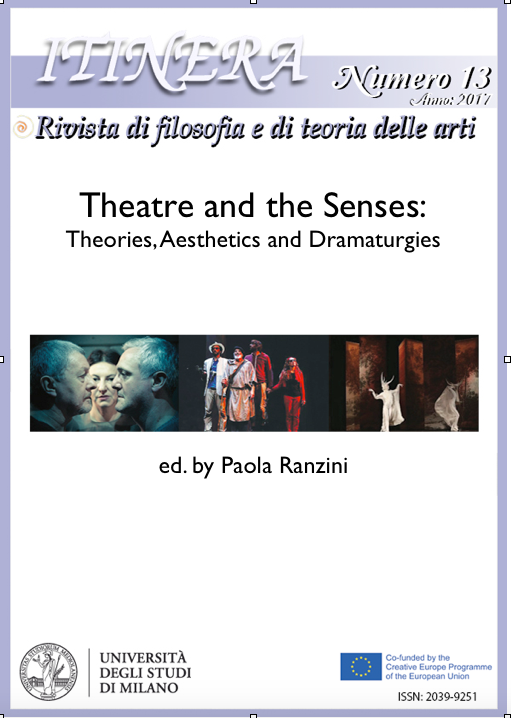Les coulisses et le sixième sens, ou l’invisible au théâtre
DOI:
https://doi.org/10.13130/2039-9251/8716Abstract
This article proposes to examine extra-sensorial tendencies in the theatre, the (third) eye that looks towards hidden, (para)theatrical spaces and phenomena. It begins by asserting the primordial role of the wings in the contemporary popular imagination, while underlining their absence from the theoretical corpus, even that questioning the spatial and experiential limits of performance. Then, through a number of examples taken from the historical development of the French theater, the study demonstrates how attention is consistently drawn towards invisible aspects situated offstage, thereby inciting the audience to further hone a sixth sense so as to fully grasp the performance.
Riferimenti bibliografici
ANSPACH, Erik, « Les Châteaux de Soulié : le diable et la transparence des mœurs au XIXe siècle », in Anne-Marie Cocula et Michel Combet eds., Le Château, le diable et le bon dieu, Ausonius, Pessac 2016.
ID., « Le théâtre et les coulisses de la famille chez Daudet » (2014), Le Petit chose, 4, 103, Paris 2014.
ID., Visibilité réduite : The Paratheater in French Literature and Culture (Ph.D. dissert.), Seattle 2011.
APPIA, Adolphe, Music and the Art of Theatre (1897), tr. Robert W. Corrigan et Mary Douglas Dirks, ed. Barnard Hewitt, Miami UP, Coral Gables 1962.
ARNAUD, Charles, Les Théories dramatiques au XVIIe siècle : Étude sur la vie et les œuvres de l’abbé d’Aubignac, Picard, Paris 1888.
BLAU, Herbert, « Who's There? — Community of the Question », PAJ: A Journal of Performance and Art, 28/2, 2006.
COPEAU, Jacques, Critiques d’un autre temps, Nouvelle-Revue Française, Paris 1923.
DEBORD, Guy, La société du spectacle, Gallimard, Paris 1992.
EL NOUTY, Hassan, Théâtre et pré-cinéma : Essai sur la problématique du spectacle au XIXe siècle, Nizet, Paris 1978.
FUCHS, Elinor, « Presence and the Revenge of Writing: Re-Thinking Theatre after Derrida » in Performing Arts Journal, Vol. 9, No. 2/3, 1985.
GENET, Jean, « Lettres à Roger Blin », in Œuvres complètes, IV, Gallimard, Paris 1968.
HARDISON, O.B. Jr., Christian Rite and Christian Drama in the Middle Ages: Essays in the Origin and Early History of Modern Drama, Johns Hopkins UP, Baltimore 1965.
HEGEL, Georg Wilhelm Friedrich, Philosophy of Fine Art (1835), tr. F.P.B. Osmaston, vol. IV, G. Bell and Sons, London 1920.
JARRY, Alfred, « Of the Futility of the ‘Theatrical’ in Theater » (De l’inutilité du théâtre au théâtre, 1896), in Michael Huxley and Noel Witts, The Twentieth-Century Performance Reader, Routledge, New York 1996.
JASPERS, Karl, Tragedy is not Enough (1948), tr. Reiche, Moore et Deutsch, Golancz, London 1953.
PATUREAU, Frédérique, Le Palais Garnier dans la société parisienne: 1875-1914, Mardage, Liège 1991.
PUCHNER, Martin, Stage Fright: Modernism, Anti-Theatricality and Drama, Johns Hopkins UP, Baltimore 2002.
RACINE, Jean, « Phèdre », in Théâtre complet, II, Flammarion, Paris 1965.
RAVEL, Jeffrey S., The Contested Parterre : Public Theater and French Political Culture, 1680-1791, Cornell UP, Ithaca 1999.
REY-FLAUD, Henri, Pour une dramaturgie du Moyen Age, PUF, Paris 1980.
ROLLAND, Romain, Le Théâtre du peuple : Essai d’esthétique d’un théâtre nouveau, Hachette, Paris 1913.
SCHECHNER, Richard, « The Five Avant-Gardes or … Or None? », in Michael Huxley etNoel Witts eds., The Twentieth-Century Performance Reader, Routledge, New York 1996.
STAROBINSKI, Jean, L’œil vivant, Gallimard, Paris 1961.
WEBER, Samuel, Theatricality as Medium. Fordham UP, New York 2004.
Dowloads
Fascicolo
Sezione
Licenza
Gli autori che pubblicano su questa rivista accettano le seguenti condizioni:
1. Gli autori mantengono i diritti sulla loro opera e cedono alla rivista il diritto di prima pubblicazione dell'opera, contemporaneamente licenziata sotto una Licenza Creative Commons - Attribuzione - Condividi allo stesso modo 4.0 internazionale che permette ad altri di condividere l'opera indicando la paternità intellettuale e la prima pubblicazione su questa rivista.
2. Gli autori possono aderire ad altri accordi di licenza non esclusiva per la distribuzione della versione dell'opera pubblicata (es. depositarla in un archivio istituzionale o pubblicarla in una monografia), a patto di indicare che la prima pubblicazione è avvenuta su questa rivista.
3. Gli autori possono diffondere la loro opera online (es. in repository istituzionali o nel loro sito web) prima e durante il processo di submission, poiché può portare a scambi produttivi e aumentare le citazioni dell'opera pubblicata (Vedi The Effect of Open Access).





